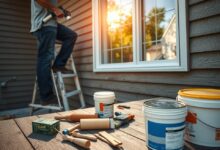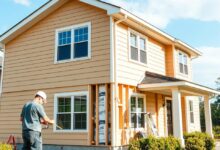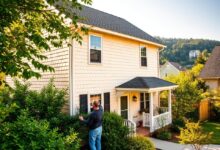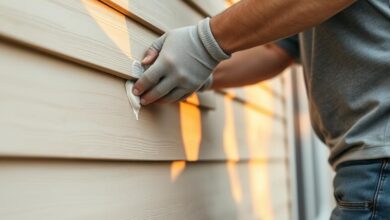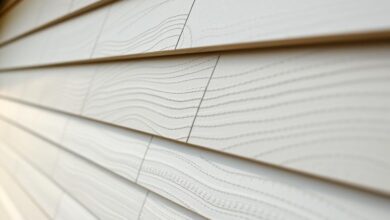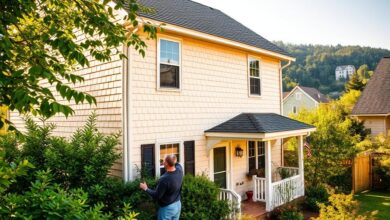The Ultimate Guide to the Best Insulated Siding for Energy Savings
Looking to cut down on energy use and lower your bills? The U.S. Department of Energy says insulation and energy-efficient siding can help a lot. Insulated siding not only looks good but also keeps your home cozy.
Choosing the right insulated siding brings many benefits. It keeps your home warm in winter and cool in summer. This guide will help you pick the best siding for your home and budget.
Key Takeaways
- Proper insulation and siding can significantly reduce energy consumption.
- Energy-efficient siding enhances your home’s exterior and maintains a comfortable indoor temperature.
- Choosing the right insulated siding can reduce heat loss and gain.
- This guide reviews various siding options to help you make an informed decision.
- Lower utility bills are a significant benefit of energy-efficient siding.
Why Your Home Needs Energy-Efficient Siding
Getting energy-efficient siding is a smart move to cut down on energy waste and save money. Homeowners always look for ways to lower their energy bills and make their homes more comfortable. Installing energy-efficient siding is a great way to do this.
The Impact of Poor Insulation on Energy Bills
Poor insulation can cause a lot of energy loss in homes. Research shows homes without good insulation can lose up to 30% of their heating and cooling energy. This not only raises energy bills but also wears out heating and cooling systems faster.
How Insulated Siding Works
Insulated siding acts as a shield against outside temperatures. It keeps homes warm in winter and cool in summer. It does this by adding insulation to the siding, which blocks heat from moving in and out. This leads to a steady indoor temperature and less energy use.
Understanding R-Value and Thermal Performance
The R-Value shows how well insulation blocks heat flow. A higher R-Value means better insulation. When picking energy-efficient siding, knowing the R-Value and thermal performance is key. It helps ensure the siding saves energy as expected.
The Best Insulated Siding for Energy Savings
Insulated siding can really cut down your energy bills. But, picking the right one can be tough. This section looks at top insulated siding products. We’ll cover their pros, cons, and features to help you choose wisely.
ProVia Vinyl Insulated Siding
ProVia Vinyl Insulated Siding is a favorite for its toughness and energy saving. It’s a great way to lower your energy use.
Overview
ProVia’s siding is built to last and looks good too. It comes in many colors and styles to fit any home.
Pros
- Energy Efficiency: Keeps your home warm in winter and cool in summer.
- Durability: Stands up to bad weather.
- Aesthetic Appeal: Looks great in many colors and styles.
Cons
- Higher Upfront Cost: Costs more than some other siding.
- Limited Repair Options: Fixing it can be hard because of its design.
Features
ProVia Vinyl Insulated Siding has insulated backing for better heat control. It also comes with a warranty for material defects.
James Hardie Insulated Fiber Cement Siding
James Hardie Insulated Fiber Cement Siding is tough and fights off many environmental factors. It’s a lasting choice for homeowners.
Overview
This siding mixes fiber cement’s benefits with insulation. It’s a top choice for efficiency.
Pros
- Durable: Resists rot, fire, and pests well.
- Low Maintenance: Needs less care than traditional siding.
- Energy Efficient: Keeps your home comfortable.
Cons
- Heavy: Needs pros to install because of its weight.
- Cost: More expensive than vinyl siding.
Features
James Hardie Insulated Fiber Cement Siding has advanced insulation technology. It’s backed by a strong warranty.
Mastic Structure EPS Insulated Vinyl Siding
Mastic Structure EPS Insulated Vinyl Siding is a mix of toughness and energy saving. It’s a good choice for homeowners.
Overview
This siding uses EPS insulation for top-notch thermal performance.
Pros
- High R-Value: Keeps your home well-insulated.
- Moisture Resistance: EPS insulation fights moisture damage.
Cons
- Limited Color Options: Fewer colors than other brands.
- Installation Challenges: Needs special installation methods.
Features
Mastic Structure EPS Insulated Vinyl Siding has high R-value insulation and a durable vinyl exterior.
| Siding Type | R-Value | Durability | Cost |
|---|---|---|---|
| ProVia Vinyl Insulated Siding | High | High | Moderate to High |
| James Hardie Insulated Fiber Cement Siding | High | Very High | High |
| Mastic Structure EPS Insulated Vinyl Siding | Very High | High | Moderate |
| CertainTeed CedarBoards Insulated Siding | High | High | Moderate to High |
| Royal Building Products Celect Cellular Composite Insulated Siding | High | Very High | High |
CertainTeed CedarBoards Insulated Siding
CertainTeed CedarBoards Insulated Siding is known for its beauty and energy saving. It’s a popular pick.
Overview
This siding looks like natural cedar but has modern insulation.
Pros
- Aesthetic Appeal: Looks like real cedar.
- Energy Efficiency: Keeps your home comfortable.
Cons
- Cost: More expensive than some options.
- Color Retention: Colors might change over time.
Features
CertainTeed CedarBoards Insulated Siding has insulated backing for better energy use. It also has a durable exterior.
Royal Building Products Celect Cellular Composite Insulated Siding
Royal Building Products Celect Cellular Composite Insulated Siding is a premium choice. It’s durable and energy efficient.
Overview
This siding is made from a special material. It insulates well and fights off environmental damage.
Pros
- High Durability: Resists cracking and fading.
- Low Maintenance: Easy to clean and maintain.
Cons
- Higher Cost: More expensive than some options.
- Limited Availability: Not available everywhere.
Features
Royal Building Products Celect Cellular Composite Insulated Siding uses advanced cellular composite technology for top performance.
Material Comparison: Which Insulated Siding Performs Best?
With energy costs going up, picking the right insulated siding is more important than ever. It’s key to know how different materials perform.
Different materials have unique benefits for insulated siding. Let’s look at vinyl, fiber cement, and composite materials.
Vinyl Insulated Siding Performance
Vinyl insulated siding is durable and low maintenance. It’s not the highest in energy efficiency, but it’s good.
Key benefits: It’s cost-effective, easy to install, and keeps out pests and weather.
Fiber Cement Insulated Options
Fiber cement siding is durable and resists fire and pests. It’s great at keeping warm in and cold out when insulated.
Key benefits: It’s durable, stands up to extreme weather, and looks like wood.
Composite and Cellular PVC Insulated Siding
Composite and cellular PVC siding combines materials for better insulation and durability.
Key benefits: It has a high R-value, resists moisture damage, and is low maintenance.
Energy Efficiency Comparison Chart
| Material | R-Value | Durability | Maintenance |
|---|---|---|---|
| Vinyl Insulated Siding | 2.5-3.5 | High | Low |
| Fiber Cement Insulated Siding | 3.0-4.0 | Very High | Medium |
| Composite/Cellular PVC Siding | 4.0-5.0 | High | Low |
The chart shows the R-value, durability, and maintenance needs of each material.
Installation and Maintenance for Optimal Energy Savings
The right installation and upkeep of insulated siding are key to saving energy. A good installation ensures the siding works well. Regular care keeps it lasting longer and saving energy.
Professional vs. DIY Installation Considerations
Choosing between a pro or DIY installation is important. DIY might save money upfront, but it needs skill and the right tools. A pro ensures a perfect fit and avoids future problems.
Key considerations for DIY installation include:
- Understanding local building codes and regulations
- Having the necessary tools and equipment
- Being aware of the manufacturer’s installation requirements
Proper Installation Techniques for Maximum Efficiency
Correct installation is vital for insulated siding’s energy-saving benefits. It means a tight seal around openings and panels aligned right.
“Proper installation is key to ensuring that insulated siding performs as intended, reducing energy costs and making homes more comfortable.” – Expert in Energy Efficiency
Seasonal Maintenance Requirements
Regular upkeep is essential for insulated siding. Check for damage, clean it, and make sure everything is tight.
Extending the Lifespan of Your Insulated Siding
To make insulated siding last longer, check for wear often. Fix problems quickly and follow the maker’s care tips.
| Maintenance Task | Frequency | Benefit |
|---|---|---|
| Inspect for damage | Seasonally | Early detection of issues |
| Clean siding | Annually | Maintains appearance and performance |
| Check fasteners | Annually | Ensures siding remains securely in place |
Cost Analysis and ROI of Energy-Efficient Siding
Homeowners need to do a thorough cost analysis when looking at energy-efficient siding. This helps them see the upfront costs and the long-term benefits. It also shows the return on investment (ROI).
Initial Installation Costs by Product Type
The cost to install energy-efficient siding changes based on the type. For example, vinyl insulated siding is often cheaper than fiber cement siding at first. Vinyl costs between $8 to $12 per square foot, while fiber cement is $10 to $15 per square foot.
It’s important to think about these costs and how they fit into your budget. Also, consider the savings you might see in the long run.
Long-term Energy Savings Calculations
Energy-efficient siding can save a lot of money over time. It keeps your home at a steady temperature, which means you use less heat and air conditioning. This can cut your energy bills by 10% to 20% each year.
For a typical house, this could mean saving $200 to $400 annually. The exact savings depend on your location and how well your home is insulated.
Tax Credits and Incentives for Energy-Efficient Home Improvements
Investing in energy-efficient siding might get you tax credits or other incentives. The government and some states offer credits for making your home more energy-efficient. For example, the Nonbusiness Energy Property Tax Credit can help with certain upgrades.
It’s a good idea to talk to a tax expert. They can tell you about the incentives you might qualify for and what you need to do to get them.
Average Payback Period by Climate Zone
The time it takes to see a return on energy-efficient siding varies by climate. In colder areas, where heating costs are higher, you’ll save money faster. In warmer areas, it might take longer.
On average, you can expect to see a return in 7 to 12 years. This depends on the siding you choose, your local energy prices, and the weather where you live.
Conclusion
Choosing the right insulated siding is key to saving energy and cutting down on utility bills. Top brands like ProVia Vinyl, James Hardie, and CertainTeed offer great options. They meet different needs and budgets.
The best siding for saving energy doesn’t just keep heat out. It also lasts long and is easy to care for. Knowing about R-value and thermal performance helps homeowners pick the best for their homes.
Getting energy-efficient siding is a smart move for a greener, cheaper home. The right choice can lead to big savings over time and less harm to the environment. Check out the options to find the best for your needs.


